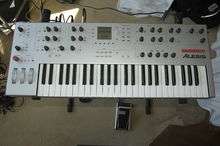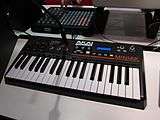Alesis Ion
The Alesis Ion is an analog modeling synthesizer. It was presented to the public on the Summer NAMM of 2002.[3] Unlike the Alesis Andromeda, Alesis's analog synthesizer, its sounds are synthesized using DSP chips to mimic the sound of analog audio circuitry and components.
| Ion | |
|---|---|
 | |
| Manufacturer | Alesis |
| Dates | 2003-2007 |
| Price | $679[1] US |
| Technical specifications | |
| Polyphony | 8 note[2] |
| Timbrality | 4 part |
| Oscillator | 3 |
| LFO | 2 |
| Synthesis type | Virtual analog Subtractive |
| Filter | 17 types |
| Attenuator | 1 |
| Effects | 4 |
| Input/output | |
| Keyboard | 49 key |
| Left-hand control | 3× Wheel |
Features
The Ion has several features that make it stand apart from other analog modeling synthesizers. Most importantly, it features a selection of emulations of classic analog filter models of synthesizers such as the Moog Minimoog, Oberheim's SEM, the Roland TB-303, the ARP 2600 and the Roland Jupiter 8. Besides these emulations (which carry euphemistic names due to trademark issues), it has a series of filter models that are not commonly found on most synthesizers, such as formant and comb filters. This vastly increases the sonic range; most virtual analogs have only a single multimode filter (usually featuring low-pass, high-pass and band-pass modes) which was either designed from scratch or "inspired by" an existing "famous" filter model. The fact that two of these filters can be used in a parallel or serial configuration adds to the sound design possibilities.
Besides the selection of filters, it has an extensive modulation matrix. This allows the user to route a source (such as an LFO) to various targets with an adjustable intensity. The Ion's extensive "Mod Matrix" rivals the routing options of some voltage-controlled modular synthesizers.
While most virtual analog synthesizers are equipped with on-board effects, the Ion lacks two important ones; reverb and a long delay (the on-board delay only has 80ms of delay time). These are often used on synthesizers to add some atmosphere to what would otherwise be a "dry" sound.
One feature that also sets it apart from other virtual analog synthesizers, is the high resolution of the endless rotating front panel knobs yielding a more precise real-time tweaking experience. This high resolution eliminates all "stair stepping" or quantization of parameter value changes. These are not encoders, but real endless potentiometers.
The Ion's keyboard has velocity sensitivity, but not aftertouch. However, the sound engine is capable of responding to both channel and polyphonic aftertouch messages received via MIDI. This feature means that with an external polyphonic aftertouch keyboard controller, the Ion can be made to modulate notes individually with finger pressure.[2]

played by Miley Cyrus
Alesis Micron
The little brother of the Ion is the Alesis Micron, which is extremely compact and portable. It came out in 2004 with almost the same synthesis engine and the same metal/plastic housing style as the Ion, but with only 37 keys and fewer knobs and buttons. It boasts reverb, long delay, and a pattern sequencer. Sound patches for the Ion can be used on the Micron[4] and vice versa. The Micron's user interface features many shortcuts and is quite deep, offering users the ability to edit all of the sound engine's parameters.[5] However, due to the lack of knobs on its control surface compared to the Ion, specialised Micron patch editor software has been made for various platforms to enable easier sound sculpting from a computer via MIDI.
Akai Miniak

In 2009, Alesis's partner Akai released its Akai Miniak, which has the same sound engine as the Micron, but in a differently styled plastic housing, with three modulation wheels instead of the Micron's two sliders plus one wheel, and with a different set of presets. Unlike the Micron, the Miniak standard comes with a gooseneck microphone. Pricing of the Miniak was substantially - typically 50% - higher upon release than the Micron's. In mid-2010 the price was dropped drastically.
Users
The Ion is used by:
- Klaus Schulze[6]
- Pedro the Lion (on their Achilles Heel LP)
- Tiny Tide (on their Moontalking Album LP and Febrero Album LP)
- Still Flyin'
- The Killers
- Spacehotel
- Puro Instinct
- Oneohtrix Point Never (Daniel Lopatin on Instrumental Tourist)
- Hanz Zimmer[7]
The Micron is used by:
- Nine Inch Nails
- Steve Honoshowsky
- System of a Down
- Simain Sound Source
- Bloodhound Gang
- Ashlee Simpson
- Gym Class Heroes
- Efecto Tralalí
- Tegan and Sara
- Times New Viking
- The Veronicas
- The Personnel
- Walk the Moon
- Former Astronauts
- Clairvoyance Bell
- Bleach Blonde Dudes
- Motion City Soundtrack
References
- "Alesis Ion". 2015-06-06. Archived from the original on 2015-06-06. Retrieved 2018-09-24.
- "Alesis Ion". Sound On Sound. September 2003. Archived from the original on 6 June 2015.
- "Archived copy". Archived from the original on 2006-08-27. Retrieved 2006-08-09.CS1 maint: archived copy as title (link)
- "Alesis Micron". Sound On Sound. January 2005. Archived from the original on 9 June 2015.
- Alesis, "Micron Reference Manual" Archived 2014-07-14 at the Wayback Machine
- "Klaus Schulze's Instruments", Klaus Schulze Official Website
- "Hans Zimmer Studio Pictures by Peter Gorges", MATRIXSYNTH website